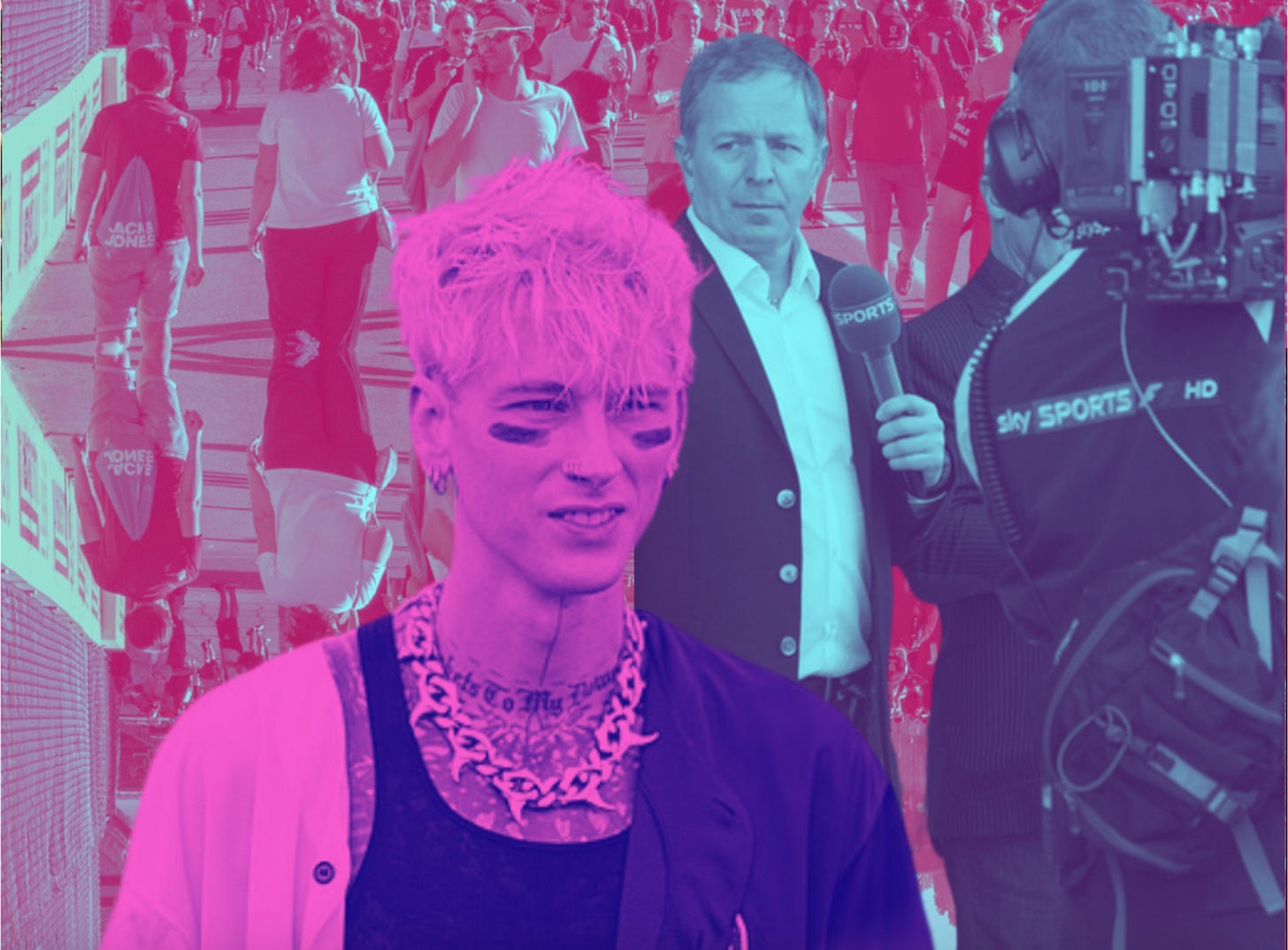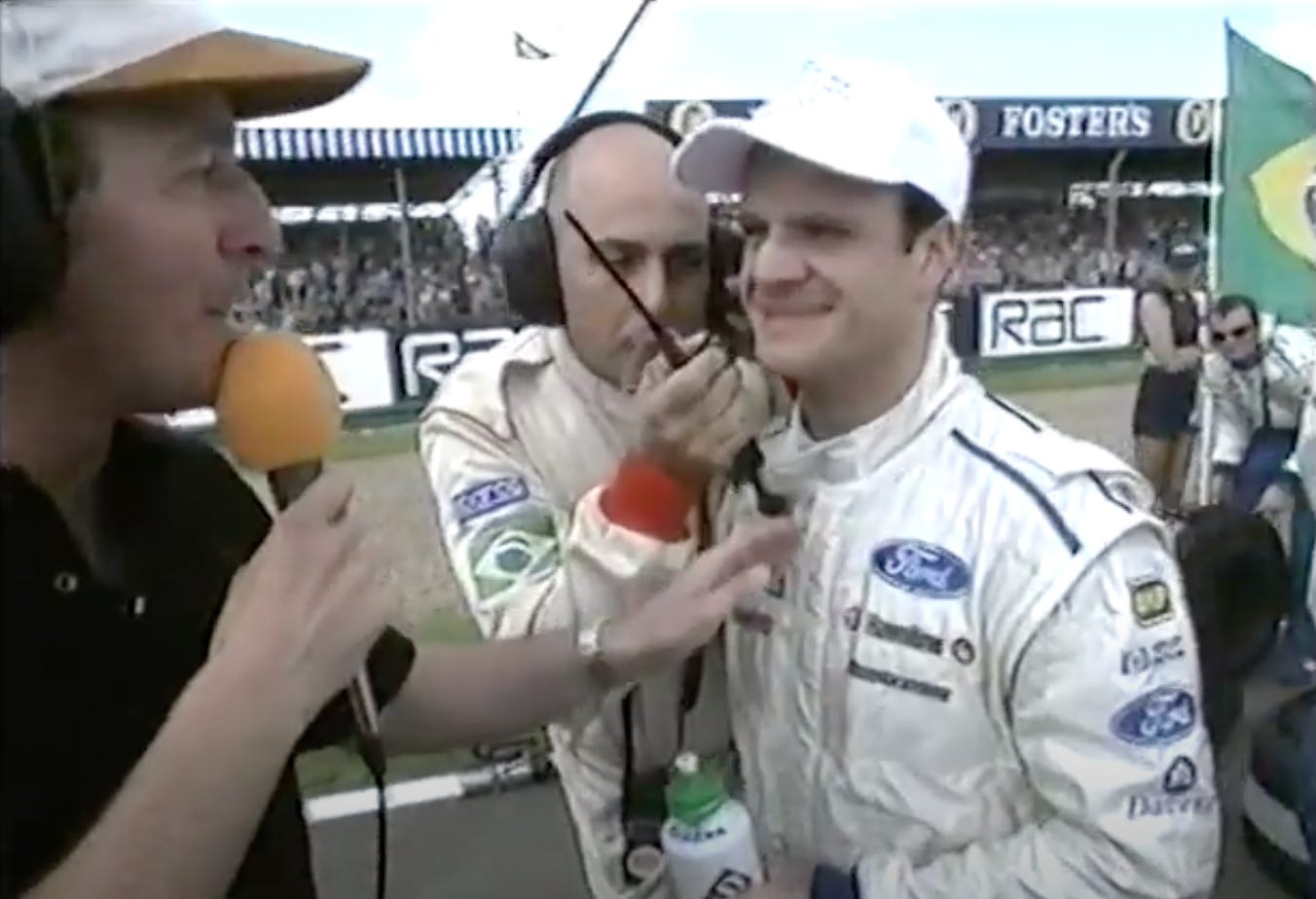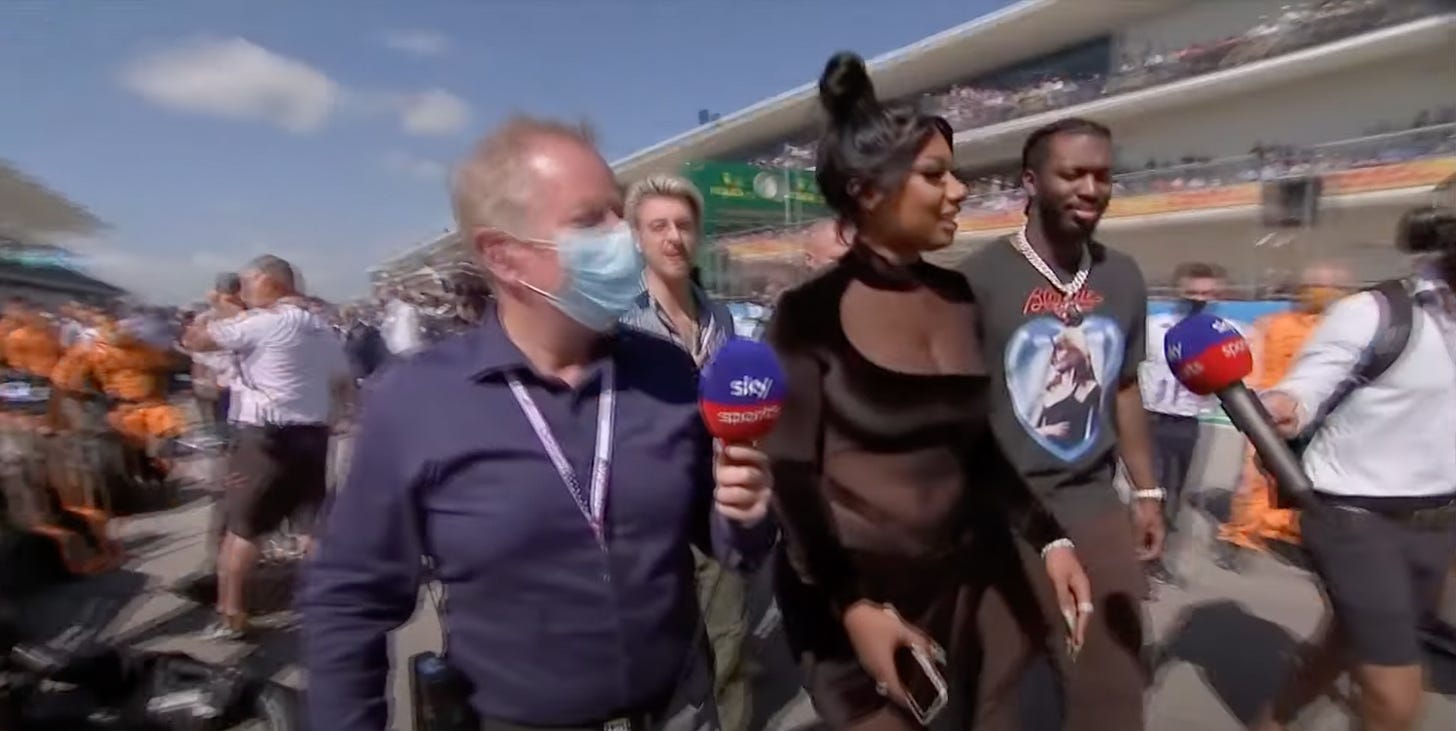A New Grid Walk Era
After 25 years, Martin Brundle’s grid walk has become a clash of Formula 1’s old guard and new priorities
This story was written with as part of a motorsport zine collaboration, which you can find here.
Martin Brundle will not play the air guitar.
In one of the most watched 2023 interviews, Brundle stops Machine Gun Kelly on the grid ahead of the São Paulo Grand Prix, clueless to the interview that would follow.
After Brundle introduces himself, he welcomes a dazed Machine Gun Kelly to the grid.
“I have no idea what you said, but thank you.”
The interactions that follow are cordial, if not forced, and a little nonsensical, with Brundle curious about the rapper’s interest in the business of Formula 1.
But then Machine Gun Kelly turns the question on Brundle: “What do you think of my business?”
Brundle keeps his head, saying that the music industry and F1 have always shared a synergetic relationship.
The interaction that followed — Machine Gun Kelly asking Brundle repeatedly to do an air guitar, or air piano, and Brundle repeatedly refusing — would suggest the relationship is anything but synergetic.
Since 1997, Brundle has hosted grid walks, braving the gauntlet of F1 personnel and celebrities lining the track of each circuit, producing off-the-cuff interviews that range from informative to absurd.
Recently, as F1 has grown its wealth of sponsorships and popularity, a track once solely lined with pit crew and drivers has become overflowed with celebrities, whose interest in the sport varies greatly — as does Brundle’s success interviewing them. As a motorsport great tries to connect with the big names representing big brands, the interactions that follow represent the meeting of the past and future of the sport.
How well these two eras gel could be indicative of what’s to come in F1.
The incongruity of Brundle’s unassuming presence and earnest approach to question-asking with high-profile celebrities is part of the grid walk’s charm. Brundle, though unobtrusive, is a giant of F1 — considered one of the greatest drivers to never win a grand prix, and rival to Ayrton Senna in F1’s feeder series. He’s clearly qualified to be asking questions to grid-walkers, but the success of those interviews relies heavily on the willingness of the interviewee to engage with Brundle’s distinct British awkwardness.
At the 2023 British Grand Prix, for example, actor Cara Delevigne snubbed Brundle of an interview despite Brundle insisting that individuals on the grid prior to a race are required to speak with the media.
Delevigne later said she was asked to decline an interview, and Alfa Romeo, who hosted her, tweeted, “Respect goes both ways: nobody should be placed in an uncomfortable situation or forced to do things against their will.”
The interaction was inconsequential but the implications were clear: Why host celebrities at an event that they don’t seem to want to engage with?
It wasn’t always like this. At the 1997 British Grand Prix, a young Brundle walked up a sparsely populated grid ahead of the race looking for familiar faces to interview.
“Rubino,” Brundle calls out, placing a hand on Rubens Barichello’s shoulder. He asks him how the Brazilian driver will fare starting at the back of the grid after three engine failures the day prior.
At one point, Brundle moves to the side to let a car drive past him, not batting an eye.
Four years later at the 2001 British Grand Prix, the grid before lights out was noticeably busier.
At this grand prix, Brundle trials a new segment of his grid walk, “Marty’s Random Person.” He spots a man who ends up being a French journalist who predicts that Mika Häkkinen will win the race.
Brundle notes that the grid is full of celebrities, but the audience watching doesn't see them. Instead, we see Brundle poking fun at a retired Damon Hill’s luscious long locks and trying to ascertain information about car set-ups and team morale based on his interview snippets. The interviews are a trove of F1 lore.
Two decades later, though the format of the grid walk remained the same, its content had shifted to accommodate the growing celebrity population on track.
In a recent flashpoint, Brundle attempted to interview Megan Thee Stallion, a guest of Red Bull at the Grand Prix (and brand ambassador of CashApp, one of Red Bull’s sponsors) at the 2021 U.S. Grand Prix. Though Megan Thee Stallion seemed interested in speaking with Brundle, her bodyguard shut down the interview, saying Brundle couldn’t speak with the rapper.
“I can do that because I did,” Brundle replied. The saying would later appear in Brunde’s Twitter bio and in several meme iterations.
But beyond the conduct of the interviewees or their handlers, the very presence of celebrities on the grid has caused controversy.
At the 2023 Spanish Grand Prix, Brazilian footballer Neymar stayed on track even after the grid walk period, standing on the grass at the start of the race’s formation lap. The footballer’s potentially dangerous situation forced the FIA to crack down on grid walk access.
Fans are left wondering why celebrities show up to the event if they’re going to act clueless or entitled.
After all, F1 tickets are expensive — ahead of the Last Vegas Grand Prix, drivers such as Daniel Ricciardo called on F1 to make the sport more accessible to those across socioeconomic lines. The unlimited access celebrities are granted in return for what fans deem little interest in the sport itself has been criticized.
Even Brundle himself has commented on the influx of famous faces on the grid: “I like to call out some of the celebs that I think are just using the grid a little bit if I'm honest,” he told the Sun in November 2021. “They don't really have a passion.”
"I know there are millions of fans at home going 'I should be on that grid. I'm a massive Formula 1 fan, not them.’”
If F1 cars are becoming moving billboards, then F1 grids and garages are the new red carpets. Celebrities, even if they are fans of the sport, can get free advertising by simply being present at grands prix.
This is the new reality of the sport.
And if Brundle is to continue his grid walks, he has an important decision to make: How much will he engage with celebrities, and how much will he push back and snub them? How much will he accept the direction the sport is heading in, giving increased access and attention to F1’s deep-pocketed supporters?
The dilemma hardly pertains to just Brundle.
Every member of F1’s old guard, even loyal fans, must determine the amount of frills the sport needs. And in exchange, the Formula One Group and FIA guiding the direction of the sport must figure out how much dissent from F1 purists they want to consider.




